Sudan and Iran: A Diplomatic Thaw Amidst Internal Strife
Sudan's Acting Foreign Minister, Ali Al Sadiq, recently made a historic visit to Iran, the first high-level trip in seven years. This visit highlights the warming relations between the two nations, occurring against the backdrop of Sudan's ongoing internal conflicts.
President Raisi of Iran pledged support for a stable Sudan and territorial integrity, while Foreign Minister Amir-Abdollahian welcomed embassy reopenings and offered expertise in various sectors.
This rapprochement follows months of high-level communication, marking a significant thaw since severed ties in 2016. Historically, Sudan and Iran have enjoyed close ties dating back to the 1990s. However, the 2016 Saudi embassy attack in Tehran led to a diplomatic break.
Sudan's recent shift towards Iran is seen as a strategic move, potentially seeking military assistance for its struggling Armed Forces against the RSF. This alignment raises concerns about Islamist groups gaining power and complicating efforts to stabilize Sudan.
Diplomatically, the move signifies a response to strained relations with, a supporter of the RSF, while providing Iran access to the Red Sea and regional influence. Sudan's stance on Palestine remains unchanged, supporting the Palestinian cause during Al Sadiq's visit.
However, this pivot could strain relations with Western nations wary of the RSF, potentially isolating Sudan further. The future of Sudan-Iran relations hinges on navigating internal conflicts, regional dynamics, and international concerns.



Comments
Post a Comment